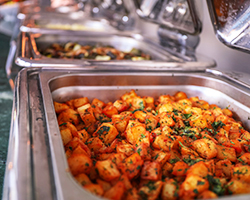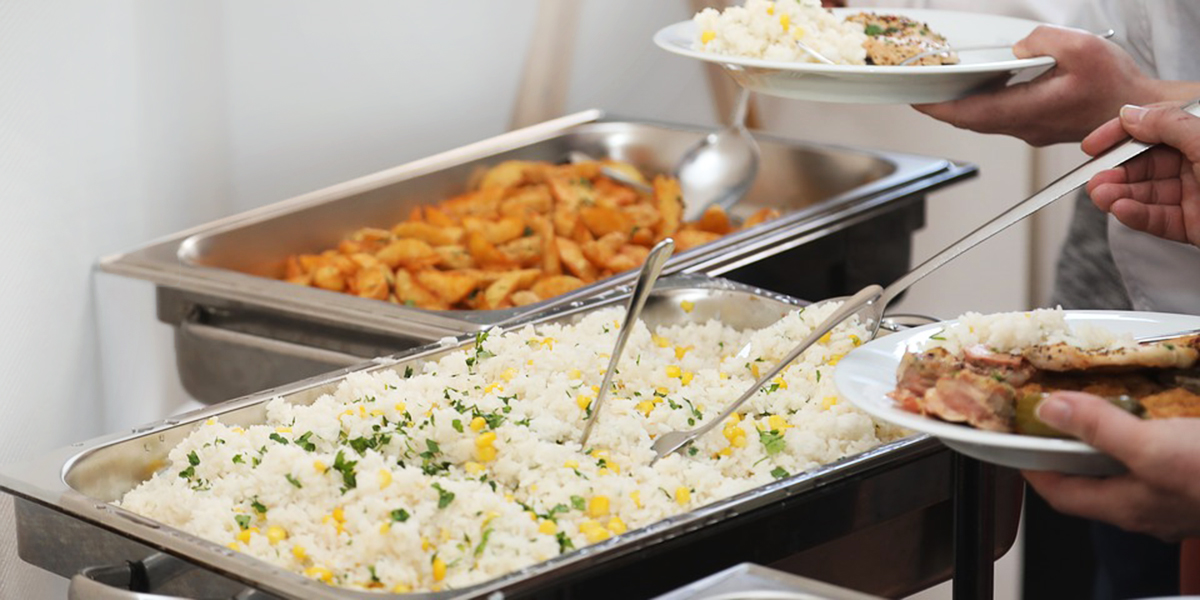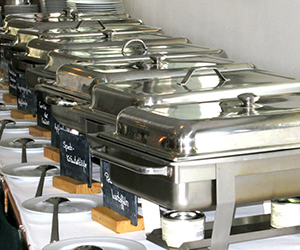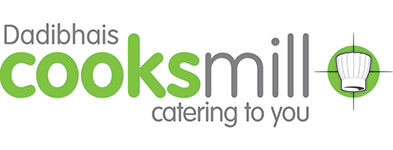Chafing Dishes: Everything You Need to Know

You’ve probably come across some of those large shiny metallic dishes caterers use in elegant buffet displays, hotels, and restaurants. The intriguing thing is the way they somehow manage to keep the food warm and steamy. Those dishes are what we call chafing dishes, read on to learn everything there is to know about them.
Why is it called a chafing dish?

The word “chafe” is derived from an old French word “chaufer” meaning “make hot”. A chafing dish or chafer for short is a pot that keeps food warm during serving. Keep in mind that the dish does not cook the food; it just keeps it hot or warm for some time. When serving in buffets and eateries, the food should be kept at a minimum of 60°C (140°F), which is where a commercial chafing dish comes in handy.
How do you use chafing dishes?
To understand how a chafing dish works, you must first learn about how it is constructed. The dish consists of a support stand, water tray, food pan, lid, and heat source. Depending on the model, the heat source can take the form of fuel cans containing a flammable gel or liquid, or electricity.
You have to put everything together for the dish to work. Begin by placing the fuel cans (of which there are usually two) in the slots or rack at the bottom of the stand. Then, place the water tray on the top rack, which you’ll then fill with boiling water up to the recommended level. Next, place the food pan, preferably with hot food in it, on top of the hot water bath.
Finally, undo the lids on the fuel cups and set them alight. You can then pop the top lid to cover the food. In the case of an electrc chafer, just plug into a mains outlet and switch it on. The fuel heats the water bath, which transfers the heat to the food above it, keeping it steaming hot. Once the food pan is empty, turn off the heat and disassemble the dish for cleaning and storage.
What fuel do you use in a chafing dish?
There are generally two types of fuels used to heat chafing dishes. The first and arguably the more popular is a methanol or ethanol gel. The gel is packaged in a metallic cylinder fitted with a resalable lid at the top. The second type of fuel is liquid diethylene glycol (glycol for short). The liquid needs a wick to burn and is kept in a tightly sealed metal container.

How long can you keep food warm in a chafing dish?
Depending on the type and amount of fuel, the dish can remain heated for 2-6 hours. After the fuel runs out, you’ll have to refill or replace the fuel cups.
As long as the temperature in the dish stays above 60°C, the food can remain safely in there for several hours. However, food kept in a chafer for longer than four hours begins to lose freshness and may even start to dry out.
Should I choose an electric chafing dish?
Both electric and fuel-based chafing dishes serve the same purpose. Their differences only matter when it comes to the convenience of use. Electric chafing dishes are mostly used indoors where there might be fire hazards and in windy catering sites where fuel-based chafing dishes are unreliable.
The problem with electric chafers is that they must be connected to a power source, which limits their mobility usability. But, on the bright side, you don’t have to keep refuelling.
What are the different types of chafing dishes?

Besides the differences in heating methods, chafing dishes came in a variety of designs to suit specific uses. The sizes also vary even with the Gastronorm chafing dish that is built to standard specifications.
The most popular chafing dish design has a rectangular or oval shape and is mostly used to hold main course meals. There is also a round chafing dish; variations of this design are used to serve desserts, soups and beverages.
The top lids also feature various designs. We have the dome or flat lids that can either be hinged or completely detachable. Roll top chafing dishes are also very popular for their convenience and ease of use. You could even have top covers made of glass.
How do you clean a chafing dish?
Most chafing dishes are made of stainless steel. Some high-end products are coated in a layer of silver. Proper cleaning maintains the appealing metallic shine on the surface of the dish and prevents the accumulation of grime and rust.
While cleaning a chafing dish, first disassemble it and clean every component separately. Use hot soapy water to clean the trays, lid, fuel cup holders, and stand thoroughly. Don’t use any abrasive material while scrubbing; otherwise, you’ll risk scratching the smooth surfaces. After that, rinse everything and wipe away any traces of water using a dry cloth. It’s best to store the dish disassemble and dry in a moisture-free environment.
Bonus tips: things to avoid when holding food at a buffet table
Observe the following safety tips when holding food at a buffet table:
- Do not add fresh food into a dish that already contains food.
- Ensure that every dish has the appropriate serving utensils.
- Monitor the food temperature and don’t let it fall below 60°C.
- Keep away flammable material from the open flames of the fuel.
- Maintain the water bath at the recommended level.
- Ensure that the food remains covered when not being served.
While we have you, check out our selection of catering and kitchen products. When it comes to cutlery and crockery, Cooksmill has got you covered. We do chafing dish wholesale supplies and retail, and the same goes for every item in our catalogue. All our chafing dishes can be seen 7 days a week at our Manchester store or bought online. Online orders have free delivery over £50 and fast courier delivery on all orders.
Sign up to Cooksmill's Newsletter!
Receive all the latest offers, competitions, new products, and current blogs.
